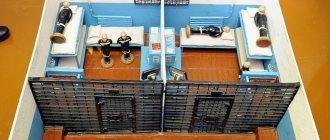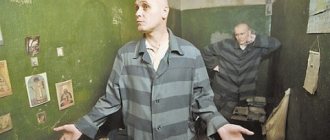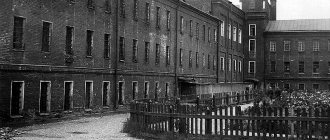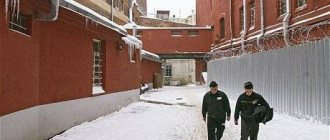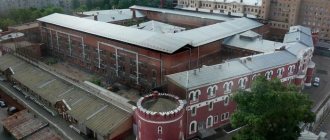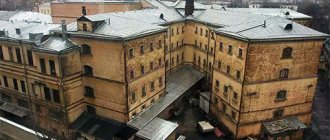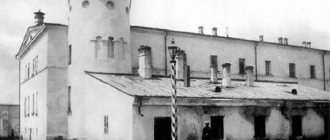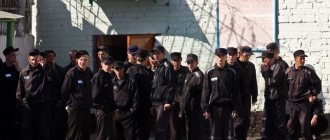Author: PREDATOR
January 30, 2016 16:00
Tags: White Swan prison history facts
114928
11
"White Swan" is a special regime prison. Its former name was “VK-240/2”. The official name today is FBU IK-2 GUFSIN. At the moment, “White Swan” is a prison that houses more than two and a half thousand prisoners. Its capacity limit is 510 seats. Let's take a closer look at what the White Swan prison is. The history of where the institution is located - all this information will also be given below.
0
See all photos in the gallery
In what conditions are convicts kept?
During the first ten years of imprisonment, convicts are prohibited from long visits with relatives.
They can receive letters and parcels once a year.
If a prisoner strictly complies with the rules of the prison and does not receive reprimands, then after ten years his conditions of stay in the colony may be softened. The prison is self-supporting.
On its territory, vegetables are grown in greenhouses, and prisoners participate in the procurement of meat and other food products. In addition, there is a production workshop within the colony.
Features of keeping prisoners:
- There is a church on the territory of the prison (priests come to the prison on church holidays).
- Particular attention is paid to the cultural development of prisoners (concerts and events are regularly held in which the convicts themselves take part).
- Strict control measures are applied to prisoners (they must move around the territory of the colony, bending forward 90 degrees with their hands behind their backs; violation of prison rules is punishable; the daily routine of convicts must correspond to a specific schedule).
- A maximum of three prisoners can be kept in one cell (a psychologist first works with them to determine their psychological type).
- During the first years of imprisonment, you are only allowed to use the library and watch TV (convicts are not allowed to work or study for a certain period of time).
- Walks are carried out in a specially equipped yard (prisoners are watched by guards with dogs, the yard resembles a cell, prisoners see the sky through the bars).
- If an observation window opens in a cell door, then prisoners must stand facing the wall and raise their hands (movement can only be carried out when the window is closed; a similar rule applies to other options for the presence of guards in cells).
- Many prisoners cannot withstand the strict regime of prison and commit suicide (some prisoners die from progressive diseases).
Crosses
The most famous prison on the banks of the Neva. Built at the end of the 19th century, the jail got its name due to its remarkable cruciform body. Only prominent figures and very influential people served sentences in Kresty. In the first years of the prison’s existence, Lev Gumilyov, Joseph Brodsky and a whole list of other notable personalities were imprisoned under the pretext of counter-revolutionary activities. Anna Akhmatova's husband and son were rotting in the dungeons of Krestov. Not far from the prison territory there is a monument dedicated to the poetess, on the slab of which lines from her “Requiem” are engraved, dedicated to the difficult fate of his wife and mother, whose closest and dearest people were imprisoned in the Crosses. After the fall of the Soviet Union, the prison was so overcrowded that small cells held 20 people. Those days are remembered for loud riots among prisoners. Years passed before Kresty was reformed, modernized and received the status of an elite, even with the prefix VIP, prison. Many prominent figures in the criminal world received unprecedented levels of comfort and privilege in prison.
Information
The colony has one of the toughest regimes in the correctional system (the average term of serving sentences is from three to seven years)[2].
Variants of the unofficial name came, according to different versions, from the color of the walls or, more plausibly, from the way prisoners moved around the territory: leaning forward (almost 90 degrees) with their arms thrown behind their backs, that is, “swan”. There is another version of the name, which comes from the fact that in the prison yard there is a monument to white swans[1]. Another explanation contains a rather romantic version, according to which it was believed that the prisoners themselves came up with such a name. Many of them had their last “berth” here, their last swan song, as according to legend, where a swan, having lost its beloved, sentenced itself to loneliness or death, quickly fell down, crashing on the ground[3].
Currently, those convicted of especially serious crimes are serving life sentences in the colony. These are murderers, rapists, members of gangster groups, leaders of organized criminal groups, who are responsible for such serious crimes as hostage-taking, kidnapping, contract killings, etc. Currently, there are about 300 people in it[3].
In the cells of the “White Swan”, convicts for life are imprisoned in groups of one, two and three. Each block with two cameras has dossier cards: photos, articles, short biography. The administration, having studied the prisoners, resettles them based on psychological compatibility in order to avoid conflicts. For this purpose, a professional psychologist works with everyone. The conditions of imprisonment meet the requirements of international standards - there is a library, you can correspond, buy some affordable things in the prison kiosk, take a walk once a day if desired, and take a shower on Fridays, and more[4].
In January 2008, the famous White Swan colony, as well as other colonies that in 1938 were part of the administration of the Usolsky camps of the Perm Territory, celebrated their 70th anniversary.
On December 5, 2022, a fire broke out on the territory of the colony. A three-story brick building measuring 30 by 60 meters caught fire. The possible cause of the fire is arson and a malfunction in electrical equipment.
Mikhail Ustinovich
Mikhail Ustinovich is a truly legendary inhabitant of the “White Swan”, who is still there. This is a famous Moscow raider who operated in the 1990s. His gang has more than 20 robberies, many robberies and four murders.
The criminal was found thanks to a hat lost during the robbery. During this raid on the merchant, two guards were killed. The smell of the hat was preserved, and subsequently, when Ustinovich was arrested while trying to hand over the stolen valuables to a pawnshop, he was identified. In 1996, the bandit was sentenced to death, commuted to life imprisonment.
Mikhail Ustinovich
In the 2000s, journalists came to him and asked if he would like to live forever. Ustinovich stated that life imprisonment was worse than any death, and that he would prefer to be executed.
In 1998, the head of the Saransk organized crime group, Andrei Volkhov, was imprisoned in the White Swan. Just like Ustinovich, he was first sentenced to death, which was later commuted to life imprisonment. Volkhov's group was engaged in robbery, robbery, and extortion. She has a lot of brutal murders to her name. In particular, in 1995, Volkhov personally shot and killed his rival, Garik Keshabyan, then his body was dismembered, and the parts were buried in different areas of Moscow.
In 2008, at a meeting with journalists, Andrei Volkhov admitted that he sincerely repented of his actions and asked for forgiveness from the relatives of his victims.
Address and contacts
- Address. The official address of the prison is Perm Territory, Solikamsk, Karnalitovaya Street, building 98. Postal code - 618540.
- Contacts. Phone numbers for contacting the administration - 8 (342) 537 21 36.
- Working hours. The White Swan correctional facility is open every day from 8 a.m. to 5 p.m., with a lunch break from 2 to 3 p.m.
- Main resource. The prison is completely self-sufficient - in the courtyard there is a greenhouse with the necessary vegetables, and small livestock and poultry are also kept. After a 5-year stay within the walls of the colony without any complaints, prisoners are allowed to work on machines where convicts build furniture and household items from wood.
- White Swan Prison on the map.
“White Swan” does not have an official website, but there is an unofficial source where relatives and friends of prisoners share information with each other (https://lebedsolikamsk.nethouse.ru/).
Official name. The official name of the institution is FKU “IK-2 OUCD GUFSIN of Russia in the Perm Territory.”
Management. The head of the prison is V.K. Khomko. Deputy Heads: V.V. Shmal, V.V. Likhvarev, R.N. Koshelev, I.Ya. Rizakhanov, Sh.A. Khasamedov. In total, 564 employees work in the colony.
SIZO “Matrosskaya Tishina” - why is it called that? You will find the answer on our website.
Video about one of the most terrible prisons in the Russian Federation - “White Swan”:
https://youtube.com/watch?v=zL7m2qEtm9E%3Fecver%3D1
General information
The institution is located in the Perm region, in the city of Solikamsk. The address where the White Swan prison is located is st. Karnallitovaya, 98. The correctional facility employs 564 people. A specialized basement workshop is also provided on the territory of the zone. It employs about 700 cabinetmakers. The institution operates at its own expense. Meat, vegetables, and poultry are prepared here. A greenhouse was also built on the premises. Greens, cucumbers, etc. are planted in it. Cultural development is also provided for in the White Swan FBU. The women's prison, located nearby, sometimes sends the theater of jokes and parodies "Matryoshka Show" to the institution with concerts. In the center of the territory there is a small Orthodox church. It was built by the prisoners themselves. The consecration of the icons and the church itself was carried out by a minister from Solikamsk. He comes to the territory where the White Swan prison is located on all Orthodox holidays. The minister teaches prayer, conducts baptismal ceremonies, and reads the liturgy.
×
0
Story
The founding date of the prison is considered to be 1938. This year, on the site of the modern colony, a labor camp for correctional labor was formed, and a commandant post was formed in the city itself.
After the end of the Second World War, former priests who were disliked by the state, convicted members of the elite and the creative intelligentsia began to be sent to the colony.
In the 50-60s, the so-called “thieves in law”, authoritative criminals, began to be sent to prison.
In 1999, the colony changed its profile and became a refuge for those sentenced to life imprisonment.
There was no need to rebuild the building of the institution - the structure was originally erected with the expectation that it would be impossible to escape from it.
That same year, 24 suicide bombers were sent to the colony.
Repurposing
Since 1999, the White Swan has been a prison for life prisoners. There were no fundamental changes to the structures. Initially, the construction of buildings was carried out with the expectation that no one would be able to escape. In addition, any connection with the free world was excluded. According to statistics, for every prisoner serving time within the walls of a colony, there are an average of three victims. After ten years in the institution, convicts are transferred to more gentle conditions of detention. They are given the opportunity to receive letters from home, and visits with relatives are provided.
0
Who is eligible for parole and were there any releases?
Prisoners who have served a 25-year sentence are eligible for parole in White Swan.
Filing an application for parole will be complicated by the presence of numerous circumstances.
Prisoners must comply with the regime of the colony for twenty-five years and not receive reprimands. In practice, this is almost impossible.
In addition, the average life expectancy for lifers is seven years. Most prisoners die from various diseases or commit suicide.
Features of parole for life prisoners:
- You can apply for parole 25 years after the imposition of a sentence of life imprisonment;
- in case of refusal of parole, a second application can be submitted after three years;
- A prerequisite for filing an application is the absence of any comments against the prisoner within three years before the planned parole.
The strict regime and harsh living conditions of prisoners at White Swan are the main reason for the high mortality rate in this prison.
Despite the possibility of parole, most convicts do not manage to live up to this term. In the entire history of the colony, not a single successful escape was recorded.
Didn't find the answer to your question? Find out how to solve exactly your problem - call right now:
| Share with friends: |
Did you like the article? Follow site updates or.
Comments:
Salman Raduev
The Chechen terrorist Salman Raduev, who was related to Dzhokhar Dudayev himself (was married to the daughter of his second cousin), was also held here.
Raduev was arrested in March 2000. The trial lasted more than a year, and in the end the terrorist was sentenced to life imprisonment in the White Swan. In August 2002, he was taken to the place of serving his sentence, but a few months later he ended up in the prison hospital with a diagnosis of numerous hemorrhages in the internal organs. Doctors determined that the prisoner suffered from a rare type of blood incoagulability. Raduev died on December 14, 2002 and was buried at the Borovskoye cemetery in Solikamsk. According to doctors, the cause of sudden bleeding could be post-traumatic phenomena and the consequences of bullet wounds. The presence of blood incoagulability and frequent bleeding in the patient was confirmed by the Chechen doctor who treated him earlier, Khasan Baiev. However, many are still convinced: the death of Salman Raduev is a consequence of injuries received in prison.
Raduev in prison
Were there any escapes?
Initially, the prison was built according to a special project, which almost completely eliminated the risk of prisoners escaping.
Convicts are subject to 24-hour video surveillance. The colony is equipped with numerous signaling devices. The sound of a siren notifies security of attempts to unauthorizedly open doors or windows to transfer food.
However, throughout the history of the prison there were episodes of failed escapes. For example, in 1992, prisoner Shafranov, armed with a grenade, entered the office of the prison director and demanded his release along with his friend. The escape attempt failed. The criminal was neutralized.
Butyrka
Butyrka prison dates back to the times of Catherine II. In those years, the small Butyrsky farm, where military units were located, had its own prison, where state traitors and rebels were kept. Now such people are called extremists. The most famous rebel was Emelyan Pugachev, in whose honor one of the towers of the current prison is named. Nowadays, Butyrka has the status of the largest pre-trial detention center in the country. The prison does not have the best reputation among similar “institutions” regarding escapes. In Soviet times, escaped prisoners were not officially reported and such news was not disseminated, but in pre-revolutionary and post-Soviet times one often heard about escaped prisoners. Famous prisoners: Zhanna Aguzarova, Evgeny Ginzburg, Vyacheslav Datsik, Vladimir Mayakovsky, Felix Dzerzhinsky, Nestor Makhno and others.
Death of a convict
When a prisoner’s life ends, if he has relatives left at liberty, a telegram notification is sent to them. Within a three-day period, they can pick up the body or confirm by return message that they will carry out the burial themselves. If this is not done, the deceased convict is buried in the city cemetery. Relatives, however, can rebury the body after burial. Many of the prisoners are not able to withstand the harsh regime of the colony. In the history of the prison, there have been cases of suicides or deaths under unclear circumstances. Once in the colony, many behave calmly and quietly, simply waiting for the hour of their death.
White Swan Prison name history
The name is unofficial. There are several versions of why it is called that. According to one of them, it came from the way convicts moved around the territory. They walk leaning forward at almost 90 degrees. At the same time, their hands are thrown behind their backs. This pose is called “swan”. The second version is associated with sculptures that are located throughout the territory. Above the entrance to the building in which the head of the institution sits, on the lattice, behind which there are swans who are escorted facing the wall, there are swans. Even the trash cans are made in the shape of these birds. Both versions seem very plausible and fully explain the unofficial name of this correctional institution.
Schedule
The daily routine of the prisoners of the White Swan is carried out in accordance with a certain schedule. Rise occurs at six o'clock in the morning, lights out at ten o'clock in the evening. During the day, prisoners are kept in their cells.
One hour is allotted for walking every day. The daily routine of convicts serving a sentence for a long time (minimum two years) may vary.
Such prisoners are allowed to work or receive education.
Sample daily routine:
- rise 6:00, bedtime 22:00;
- one hour is allotted for a walk (specially equipped yard);
- the working day is eight hours (a woodworking workshop or a sewing workshop for women; prisoners can work only with permission from management);
- watching TV or radio is allowed for a maximum of one and a half hours a day;
- visiting the library is allowed (on average one and a half hours a day);
- prisoners can attend church (visiting times are limited);
- prisoners' leisure time consists of sporting events (football, table tennis, etc.);
- showers are allowed once a week (the duration of the procedure should not exceed fifteen minutes);
- Meals are provided three times a day (breakfast, lunch and dinner are brought to prisoners in their cells).
Prison Breaks
As mentioned above, the buildings of the institution were constructed in such a way as to completely exclude the possibility of leaving them without permission. Nevertheless, during the entire existence of the colony, several attempts were made. One of the most daring incidents occurred in 1992. Prisoner Shafranov attempted to escape. He armed himself with a grenade and entered the chief’s office with it. Threatening, he demanded to release his friend from solitary confinement, provide them with transport and ensure free exit from Russia. Shafranov was neutralized and killed. During this operation, a special forces officer was also killed. After this escape attempt, security measures in the prison were significantly increased.
Reception schedule for citizens and relatives
Reception of citizens in the White Swan is carried out by the head of FKU IK-2 of the GUFSIN for the Perm Territory and his deputies. A detailed work schedule of the prison is posted on the official website of the colony. Deviations from the existing schedule are not permitted.
Applications for short-term and long-term visits can be submitted not only to management in person, but also sent by email.
Schedule of work with citizens:
- the warden is on Wednesdays from 15:00 to 16:00 (deputies are on Mondays and Thursdays from 11:00);
- on weekends, a designated duty officer works with citizens (reception is carried out from 8:00 to 17:00);
- rooms for short-term and long-term meetings, receiving parcels and parcels operate from Monday to Thursday from 8:00 to 17:00 (on Friday from 8:00 to 16:00, on Saturday and Sunday from 8:00 to 17:00) ;
- applications are signed from Monday to Thursday from 8:00 to 17:00 (Friday from 8:00 to 16:00, Saturday and Sunday from 8:00 to 17:00).
How to get a jury trial in Russia? Find out the answer right now.
Famous prisoners
In Russia there are two famous prisons in which the thieves’ ideology was “broken”: “White Swan” and “Black Dolphin”. The latter is located in Orenburg. The legendary thief in law Vasya Brilliant was kept in the White Swan and ended his life. The famous terrorist Raduev also stayed within the walls of the colony. He passed away in 2002. The circumstances of his death, however, remained unclear. Other “legendary” prisoners include Andrei Volkhov, Mikhail Ustinovich, Alexander Pichushkin, Yuri Shutov.
0

